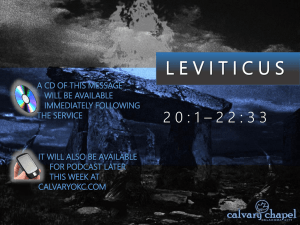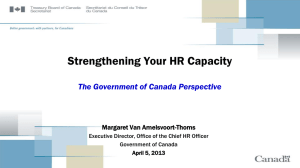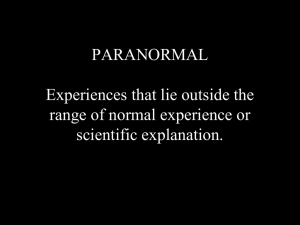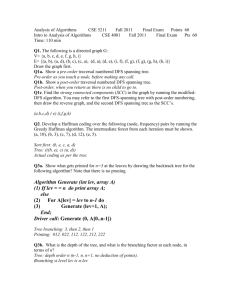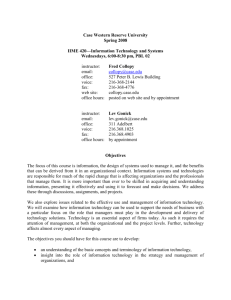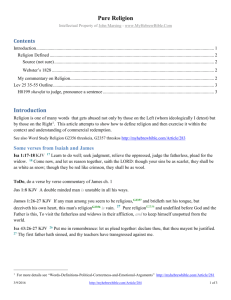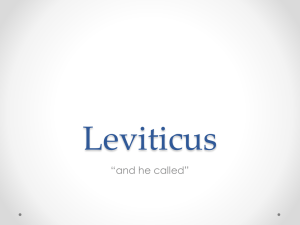Clearing the air
advertisement
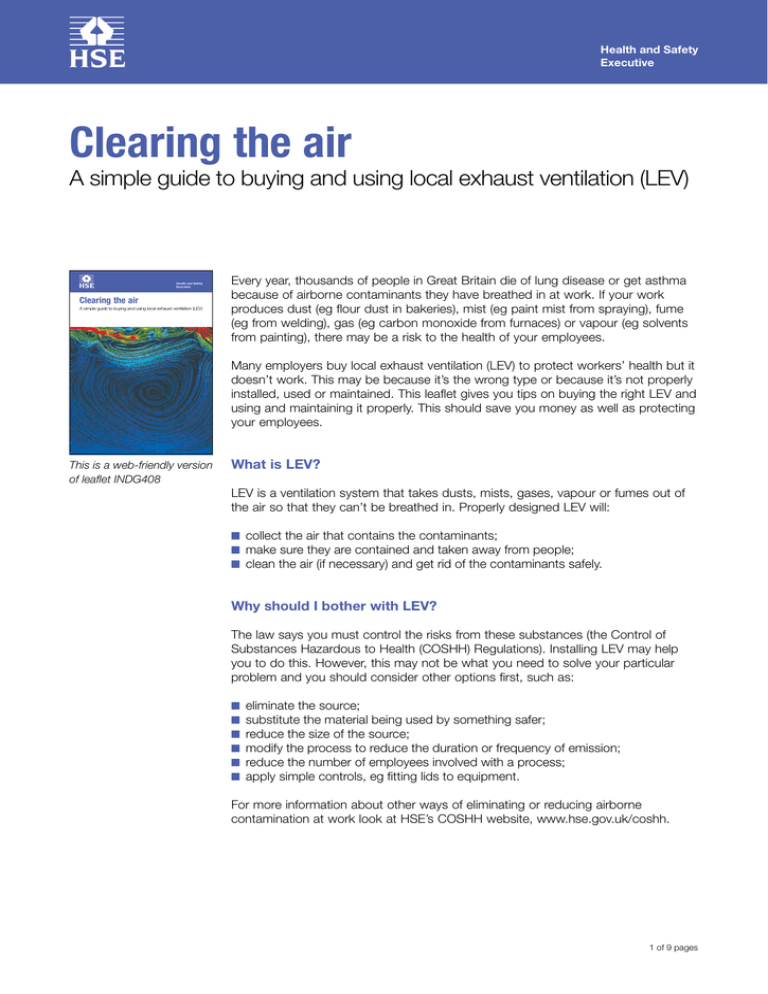
Health and Safety Executive Clearing the air A simple guide to buying and using local exhaust ventilation (LEV) Health and Safety Executive Clearing the air A simple guide to buying and using local exhaust ventilation (LEV) Every year, thousands of people in Great Britain die of lung disease or get asthma because of airborne contaminants they have breathed in at work. If your work produces dust (eg flour dust in bakeries), mist (eg paint mist from spraying), fume (eg from welding), gas (eg carbon monoxide from furnaces) or vapour (eg solvents from painting), there may be a risk to the health of your employees. Many employers buy local exhaust ventilation (LEV) to protect workers’ health but it doesn’t work. This may be because it’s the wrong type or because it’s not properly installed, used or maintained. This leaflet gives you tips on buying the right LEV and using and maintaining it properly. This should save you money as well as protecting your employees. This is a web-friendly version of leaflet INDG408 What is LEV? LEV is a ventilation system that takes dusts, mists, gases, vapour or fumes out of the air so that they can’t be breathed in. Properly designed LEV will: ■■ collect the air that contains the contaminants; ■■ make sure they are contained and taken away from people; ■■ clean the air (if necessary) and get rid of the contaminants safely. Why should I bother with LEV? The law says you must control the risks from these substances (the Control of Substances Hazardous to Health (COSHH) Regulations). Installing LEV may help you to do this. However, this may not be what you need to solve your particular problem and you should consider other options first, such as: ■■ eliminate the source; ■■ substitute the material being used by something safer; ■■ reduce the size of the source; ■■ modify the process to reduce the duration or frequency of emission; ■■ reduce the number of employees involved with a process; ■■ apply simple controls, eg fitting lids to equipment. For more information about other ways of eliminating or reducing airborne contamination at work look at HSE’s COSHH website, www.hse.gov.uk/coshh. 1 of 9 pages Health and Safety Executive What makes up an LEV system? Air mover Discharge Air cleaner Ducting Hood Figure 1 Common elements of a simple LEV system Inlet A typical LEV system will have: Hood(s) Ducts Air cleaner Fan Discharge to collect airborne contaminants at, or near, where they are created (the source). to carry the airborne contaminants away from the process. to filter and clean the extracted air. must be the right size and type to deliver sufficient ‘suck’ to the hood. the safe release of cleaned, extracted air into the atmosphere. An LEV hood may be tiny and built into a hand-held tool or it may be large enough to walk into. Here are some examples. Figure 2 On-tool extraction – soldering iron Figure 3 On-tool extraction – hand sander Figure 4 Fixed capturing hood Figure 5 Moveable capturing hood Figure 6 Small booth Figure 7 Walk-in booth How do I make sure I get the right type of LEV? When LEV doesn’t work as well as it should, a common reason is that the hood doesn’t catch or contain the contaminants effectively. It is important to match the hood to the source that you want to control. There may be a standard, ‘off-the-shelf’ system that would be suitable for you. However, it needs to be fit for purpose and capable of adequately controlling exposure. Ask your trade association or check industry guides. HSE has developed a free internet tool for identifying good control practice, including LEV: www.coshh-essentials.org.uk. Clearing the air: A simple guide to buying and using local exhaust ventilation (LEV) 2 of 9 pages Health and Safety Executive If you have to make any changes to a standard system, or if there is no standard system for your industry, get help to write a specification of what you will need (see ‘Useful links’). Take this to your LEV supplier or to a ventilation engineer to design a system that will work for you. A clear specification will help you get what you need, and avoid any misunderstandings with the LEV supplier. The specification should: ■■ describe the process, the contaminant, its hazards and the sources to be controlled, and how stringent the control needs to be. The important chemical and flammable properties of substances and products appear in the Safety Data Sheet; ■■ require indicators to be fitted to show that the system is working properly; ■■ require the LEV to be easy to use, check, maintain and clean, taking account of other risks, eg accessibility, skin contamination, and waste removal and filter changing without spreading contamination; ■■ specify that the supplier provides training in how to use, check and maintain the LEV system; ■■ require the supplier to provide a user manual that describes and explains the LEV system, how to use, check, maintain and test it, along with performance benchmarks and schedules for replacing parts; ■■ require the supplier to provide a logbook for the system to record the results of checks and maintenance. Remember to involve employees and workers’ representatives in the selection and design of LEV to make sure it is effective and practical. ■■ LEV is rarely straightforward ■■ Mistakes can be costly ■■ Use a professional unless it is obvious what to do How do I select an LEV supplier? You are responsible for making sure that your supplier is competent to do the job, and so selecting the right contractor is crucial. Follow these steps: ■■ Invite tenders, ideally from three contractors. ■■ Provide a drawing of the area and the processes to be controlled. ■■ Provide your specification for the work to be done. ■■ Tell potential contractors about any environmental or fire and explosion requirements. ■■ Ask potential contractors to visit the site to see the processes. Once you have the tenders, compare the plans and quotations with your specification. Ask potential suppliers: ■■ What experience do you have in designing and providing LEV systems? ■■ What are your professional qualifications, experience and memberships? ■■ To what industries have you supplied LEV? ■■ Have you successfully applied LEV to similar processes or activities in my industry? ■■ Can you provide references, testimonials or examples showing successful installation of LEV systems? Contact or, preferably, visit past customers to check references. Clearing the air: A simple guide to buying and using local exhaust ventilation (LEV) 3 of 9 pages Health and Safety Executive ■■ Are you tied to a particular range of LEV products? ■■ How will you show that the LEV provides adequate control? ■■ What training do you include for using, checking and maintaining the LEV system? ■■ Only buy LEV that will adequately control exposure – ask the supplier how they will prove this How do I know the LEV works? The supplier’s quotation should cover all the requirements laid out in your specification. On installation, the supplier should test the LEV to ensure it is working according to the specification. This is called ‘commissioning’ and shows that it has been installed properly and that it controls exposure. This will need your co-operation because it should be done when normal working is taking place. You and your employees will need training by the supplier in how the LEV works and how to check and maintain it. What three documents should the supplier give me? 1 A user manual with a general specification of what the LEV system is designed to control and how it achieves control. It should include: ■■ a description of the system with diagrams; ■■ performance information from commissioning; ■■ a description of checks and maintenance and replacement schedules, including frequency; ■■ a listing of replaceable parts (and part numbers); ■■ a detailed description of the specific statutory ‘thorough examination and test’ requirements and exposure targets; ■■ signs of wear and control failure; ■■ a description of how operators should use the system so it works effectively. 2 A logbook that includes: ■■ schedules for regular checks and maintenance; ■■ records of regular checks, maintenance, replacements and repairs; ■■ checks of compliance with the correct way of working with the LEV system; ■■ the name of the person who made these checks. 3 A commissioning report that includes: ■■ diagrams and a description of the LEV, including test points; ■■ details of the LEV performance specification; ■■ results, such as pressures and velocities at stated points; ■■ calculations; ■■ written descriptions of the commissioning, the tests undertaken, and the outcome. Where necessary, this should include air sampling results; ■■ a description of how operators should use the system so it works effectively. ■■ To keep control you need a user manual, a logbook, a commissioning report and training Clearing the air: A simple guide to buying and using local exhaust ventilation (LEV) 4 of 9 pages Health and Safety Executive What do I need to do once the LEV is installed? The law says that you need to make sure it carries on working properly. You will need to regularly check and maintain the LEV over the year and have it ‘thoroughly examined and tested’. To do this you will need the user manual, logbook and training. If you don’t have any of these, ask your LEV supplier for them or get professional advice. The work needs to be done by competent people (see ‘Competence’). If you have an LEV system that hasn’t been commissioned, you will need to have its performance tested to ensure that it is adequately controlling exposure. Ask the LEV examiner to provide a user manual and logbook. Checking and maintenance How often you check your LEV and how you do it will depend on how complicated the system is, how likely it is to fail, and the consequences if it does. Complicated LEV that will have serious consequences if it goes wrong needs more frequent checks and maintenance. As you gain more experience in running the LEV system, you may need to change the frequency of your checks in the user manual. Checks and maintenance tend to cover four types of parts: ■■ moving parts that may wear, such as fan bearings or filter shakers; ■■ non-moving parts, such as hoods, ductwork and seals (which can suffer physical or chemical damage and wear); ■■ parts that deteriorate with use, such as filters or flexible ducting; ■■ items that need regular attention, such as filters that need replacing, or removing sludge from a wet scrubber. If the LEV can become contaminated with toxic substances, you may need to use ‘permits to work’ and formal method statements when people work on the system. Give people responsibilities for checks and maintenance. These may overlap, for example: Operator Make daily checks, report faults Safety/workers’ representative Make weekly, monthly checks Supervisor Make weekly checks, arrange repairs, correct deviations from the correct way of working, record findings and actions Section manager Identify problems, receive regular reports from the supervisor, be responsible for maintenance and testing Works engineer Repair faults, carry out maintenance, arrange thorough examination Clearing the air: A simple guide to buying and using local exhaust ventilation (LEV) 5 of 9 pages Health and Safety Executive If there is any obvious damage to the LEV or it clearly isn’t working properly, employees should report this and you should have it repaired straight away. Also ask employees using LEV, and any workers’ representatives, for feedback and suggestions on how the LEV and working practices can be improved. What records do I need to keep? In your logbook, keep a record of all LEV checks and maintenance to show that it has been done and that the LEV is working as well as it should be. This will also help you keep track of repairs and sort problems out before they get more serious. Keep the logbook for at least five years. You also need to keep thorough examination and test reports for at least five years. What is the thorough examination and test? Most LEV systems need a thorough examination and test once each year (legally, you are allowed 14 months between tests) to make sure it works well and continues to protect your employees. Some LEV systems (such as those controlling more critical or high-hazard processes) need more frequent thorough examination and testing. The COSHH Regulations require more frequent testing for some processes. The thorough examination tests the LEV against the performance recorded in the commissioning report. It should include airflow and pressure measurements, checks on control effectiveness and, possibly, exposure measurement. If you don’t have the design performance data, you will not know whether your system is working correctly, so you may need to have your system commissioned. If your system has already been commissioned, but you have changed the process or layout since then, you need to re-commission it. A professional advisor can help you work out what you need to do. The examination and test needs to be done by a ‘competent person’. It isn’t normally something you can do yourself. You and your employees will need to co-operate with the examiner. Give them the: ■■ LEV commissioning report; ■■ LEV user manual; ■■ logbook with details of checks and maintenance activities. The examiner will attach a ‘tested’ label to all hoods. This will include the name of the examiner and the date of the next test. If a hood has clearly failed, then a red ‘fail’ label will be attached instead, and urgent action will be necessary. The examiner will give you a report of the examination and test, which should include a prioritised action plan listing anything that you need to do. If the examination and test show that the LEV isn’t adequately controlling people’s exposure to airborne contaminants, stop the work and repair the LEV. If you want work to continue while you arrange repair, employees will need further protection, such as suitable personal protective equipment and respiratory protection. The system should carry the red ‘fail’ label until it has been repaired. If the thorough examination and test report action plan contains long lists of repairs and poor performance, this tells you that your checking and maintenance is not good enough. Use the test report as an audit of your procedures and an opportunity to review all your exposure control measures. Improve them if you can. Clearing the air: A simple guide to buying and using local exhaust ventilation (LEV) 6 of 9 pages Health and Safety Executive ■■ It is your responsibility to arrange checks, maintenance and thorough examination and test – make sure you use competent people ■■ Thoroughly examine and test the LEV against the original commissioning report Competence You must make sure that anyone who designs, selects, checks and maintains the LEV system and does the thorough examination and test is competent. They should have the knowledge, skills and experience to do the job properly. There are relevant courses available (for example, see BOHS and CIBSE in ‘Useful links’). What training for operators/supervisors/managers should I provide? Training should cover the basics of: ■■ the harmful nature of the substances you use; ■■ how exposure may occur; ■■ how the LEV system works; ■■ methods of working that get the best out of the LEV; ■■ how to check the LEV is working; ■■ the consequences of the LEV failing; and ■■ what to do if something goes wrong. Keep training records for everyone. This includes refresher training. Changes to the work process mean that LEV may also need to change, and staff may need re-training. LEV checklist for employers Issue Possible solution Which sources are causing exposure? Take advice from suppliers, trade associations, professional advisors, the HSE website and other reliable sources. What type of LEV system do I need? Write a specification. If necessary, get professional advice. Be very clear about the type of LEV hood needed. Make sure that your advisor has the competence and experience you need. Has my LEV system been installed and commissioned properly? Make sure your LEV system is installed and commissioned by a competent person. Get a full commissioning report and user manual. Ensure simple instrumentation is installed to check performance (eg a hood manometer). Have I, and my staff, been properly trained? Include training in your LEV specification document. Make sure employees and the person responsible for checking and maintaining the system are trained. Keep training records. How do I check and maintain my LEV system? Look at the user manual which will list the checks and their frequency. If you don’t have one, get one written. Appoint people to do the checks, maintenance and repairs. Record any checking and maintenance details in the logbook. Clearing the air: A simple guide to buying and using local exhaust ventilation (LEV) 7 of 9 pages Health and Safety Executive Issue Possible solution Have you changed the way you work or the production process but not the LEV? Treat and plan changes to the LEV as part of any change to the production process. Don’t assume it will cope. Get the LEV system re-commissioned. How do I arrange a thorough examination and test of the LEV? Include thorough examination and test in the yearly management cycle. Make sure that your examiner has the competence and experience you need. What do I do with the report? Follow the recommendations in the test report and carry out necessary repair work promptly. The examiner has put a red ‘fail’ label on an LEV hood. Check the test report for actions needed and arrange for repair. If necessary, provide further protection for your employees in the meantime, including personal protective equipment and respiratory protection. When should I review exposure control measures? Treat the LEV examination and test report as an audit on exposure controls. Think about what more you can do to stop employees breathing in airborne contaminants. Find out more COSHH a brief guide to the Regulations: What you need to know about the Control of Substances Hazardous to Health Regulations 2002 (COSHH) Leaflet INDG136(rev3) HSE Books 2005 www.hse.gov.uk/pubns/indg136.pdf (A revised COSHH leaflet will replace this version in 2008) Controlling airborne contaminants at work: A guide to local exhaust ventilation (LEV) HSG258 HSE Books 2008 ISBN 978 0 7176 6298 2 Time to clear the air! A workers’ pocket guide to local exhaust ventilation (LEV) Pocket card INDG409 HSE Books 2008 (Single copy free or priced packs of 25 ISBN 978 0 7176 6300 2) Control of substances hazardous to health (Fifth edition). The Control of Substances Hazardous to Health Regulations 2002 (as amended). Approved Code of Practice and guidance L5 (Fifth edition) HSE Books 2005 ISBN 978 0 7176 2981 7 See also HSE’s COSHH essentials at www.coshh-essentials.org.uk Clearing the air: A simple guide to buying and using local exhaust ventilation (LEV) 8 of 9 pages Health and Safety Executive Useful links Chartered Institution of Building Services Engineers (CIBSE) www.cibse.org. Main professional engineering body offering qualifications and membership to ventilation engineers. Heating and Ventilating Contractors’ Association (HVCA) www.hvca.org.uk. Main representative organisation for companies installing ventilation systems including LEV. British Occupational Hygiene Society (BOHS) www.bohs.org. For help with process and source assessment and LEV design and specification, as well as qualifications in designing and testing LEV. Institution of Occupational Safety and Health (IOSH) www.iosh.co.uk. For general advice on choosing LEV systems. Safety Assessment Federation (SAFED) www.safed.co.uk. Represents many insurance companies doing independent engineering inspection and certification of machinery and equipment including LEV systems. Independent National Inspection and Testing Association (INITA) www.inita.org.uk. Represents companies doing independent engineering inspection and certification of machinery and equipment including LEV systems. Solids Handling and Processing Association (SHAPA) www.shapa.co.uk. Represents the major employers in LEV manufacturing. Further information For information about health and safety, or to report inconsistencies or inaccuracies in this guidance, visit www.hse.gov.uk/. You can view HSE guidance online and order priced publications from the website. HSE priced publications are also available from bookshops. This leaflet contains notes on good practice which are not compulsory but which you may find helpful in considering what you need to do. This leaflet is available in priced packs of 15 from HSE Books, ISBN 978 0 7176 6301 9. Single copies are free and a web version can be found at: www.hse.gov.uk/pubns/indg408.pdf. © Crown copyright If you wish to reuse this information visit www.hse.gov.uk/copyright.htm for details. First published 05/08. Published by the Health and Safety Executive INDG408 09/11 9 of 9 pages
